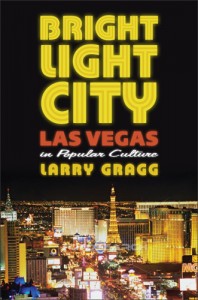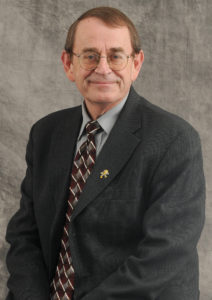S&T historian examines the lure of ‘Sin City’ in new book
Posted by Mary Helen Stoltz
Las Vegas is appealing to average people around the world because it represents an escape from the mundane, everyday cares everyone faces, says Missouri University of Science and Technology historian Larry Gragg in his latest book.
 Bright Light City: Las Vegas in Popular Culture, released on April 4 by the University Press of Kansas, examines the ways the city – and its allure – are depicted in movies, television programs, the media and popular fiction. It’s the first in a planned four-book series.
Bright Light City: Las Vegas in Popular Culture, released on April 4 by the University Press of Kansas, examines the ways the city – and its allure – are depicted in movies, television programs, the media and popular fiction. It’s the first in a planned four-book series.
“People don’t watch the news or read newspapers while they’re in Las Vegas,” says Gragg, a Curators’ Teaching Professor of history and political science and interim vice provost for undergraduate studies at Missouri S&T. “It is a place to evade the normal and to experience uninhibited fun, at least for a few days.”
Gragg first visited Las Vegas as a tourist in 1992 and he has returned every year since. He’s made nearly 50 trips in all. What began as a personal quest to understand his own attraction to Vegas led Gragg to explore what has made the city such a powerful magnet for millions of tourists over the past century.
“The reason I like Las Vegas is because it’s almost all of the things that I am not,” Gragg told a writer for the Las Vegas Weekly in a 2009 interview. “I’m rural America, I’m small-town America, I’m conservative in my personal finances, I’m not flamboyant, and Las Vegas is the opposite of all four of those.”
Gragg began by examining images of Las Vegas in pop culture and found several themes, which became the book’s chapters. He looks at Las Vegas as the last frontier town, a home for gangsters, the entertainment center of the world, a gambling hot spot and a place to find luxury and beautiful women. He also examines negativity toward the city.
“It is critical to know what images of Las Vegas Americans encountered in the nation’s popular culture that fueled their fascination with a city they had never visited,” Gragg says. “The prevailing images clearly emerge as a kaleidoscope of impressions of lights, color and sound; characters and characterizations; and praise and criticism – and, ultimately, amazement about the city that has attracted ever more people.”
In his research, Gragg examined 150 films, more than 200 televisions programs, 200 novels, nearly 1,500 newspaper articles and more than 200 magazine articles. He also reviewed a large number of relevant secondary works that depict the images of Las Vegas Americans encountered between 1905 and 2005.
Bright Light City is the first in what Gragg plans as a four-book series. Ultimately he hopes to write a comprehensive history of Las Vegas. His next book will feature the mobster Benjamin “Bugsy” Siegel. Gragg has studied 2,400 pages of FBI wiretap transcripts, read memoirs of law enforcement officials who investigated Siegel and interviewed the mobster’s daughter.
The third book in the series will examine the publicists, local journalists, civic leaders and hotel developers that created and successfully distributed appealing images of the city. The fourth book will feature Las Vegas in the 1950s, which Gragg says is a pivotal decade because it was during those years that the city became a leading tourist destination.
Gragg joined the Missouri S&T history and political science faculty in 1977. In 2003, he was named chair of the department. In 2012 he was named interim vice provost for undergraduate studies.
Gragg has authored six American history books on topics ranging from the Salem witch trials to the English colonization of Barbados. His most recent book, John F. Kennedy: A Biography,” published in 2011, was co-authored with Dr. Michael Meagher, associate professor of history and political science at Missouri S&T.
Other books by Gragg:

Leave a Reply